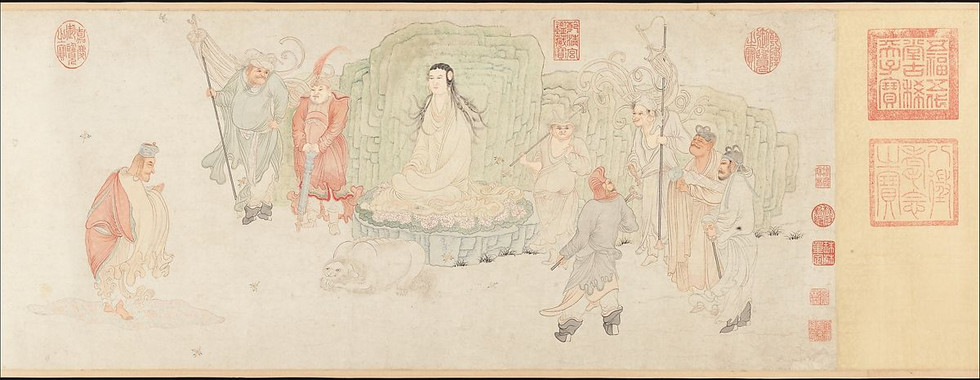Wu Bin
- megan huang
- Jan 31, 2022
- 2 min read
Courtesy Name: Wenzhong
Pseudonym : Zhiyin Toutuo which means ”Mendicant monk at the temple hidden by tree branches”
His birth and death dates are not specifically known, Wu Bin was born in the Putian, Fujian province.
He was educated in literati painting and was a devout follower of Buddhism and worked and lived in the temple of Nanjing. He often depicted Buddhist practitioners as magicians, performing superstitious rituals and healing practices, creating scenery that appealed to the other religious beliefs.
He also painted landscaped and painted with precise and delicate strokes.
Detail of landscape (ink and colour on paper)

The painting depicts a mountainside village. The main’s house is located in the midst of the mountains and the village is located at the riverside. As the converging rivers flow into the big lake. With the different shapes and structures of the mountains, Wu Bin has created this textured layered look to show the terrain of the mountains. The lighter shade of mountains depicts those further away. The balance of the mountains as it ranges in size across from left to the right of the painting. This flow as our eyes glances across the painting. The lighter washed out sections at the start of the mountain slope creates this illusion of mist and cloud.
The patterns of the mountains also link our eyes with the shape and crowding of the trees he has drawn in. We are guided down with each mountain curve and then guided by the rows of trees.
The Sixteen Luohans (Handscroll, ink and colour on paper)
In the Chinese culture, monks, conjurers, and mysterious hermits were often thought to be disguised as “living luohans,” or Buddhist holy men capable of producing miracles.
Wu Bin embraced an archaic figure style and followed the tradition of depicting luohans as fantastic eccentrics whose grotesque features hide their inner spiritual nature. He did this in reaction to the corruption and mess happening in the government. As such pressures and stresses grew, the public started to rely on their beliefs and looked towards their religions.
Wu Bin intention of a humorous painting may have had a serious message that holiness can be concealed within an outwardly incongruous form. The different figures having their awkward and more would say unappealing feature, these were the ‘luohans’ that people needed to depend on amidst their lost and stressed journey.















Comments